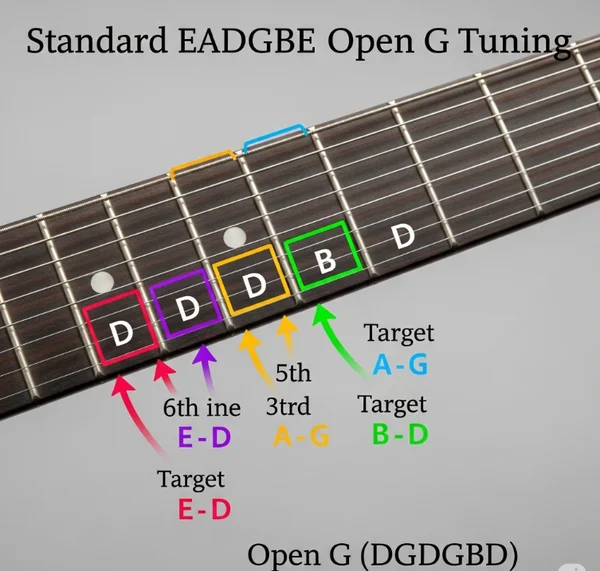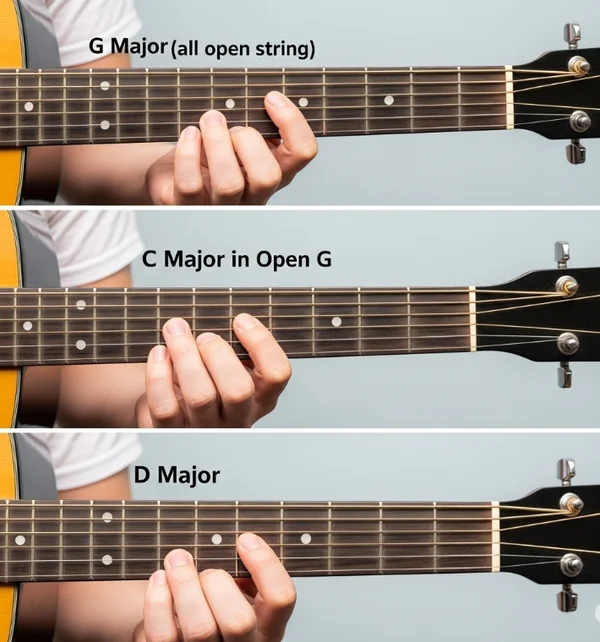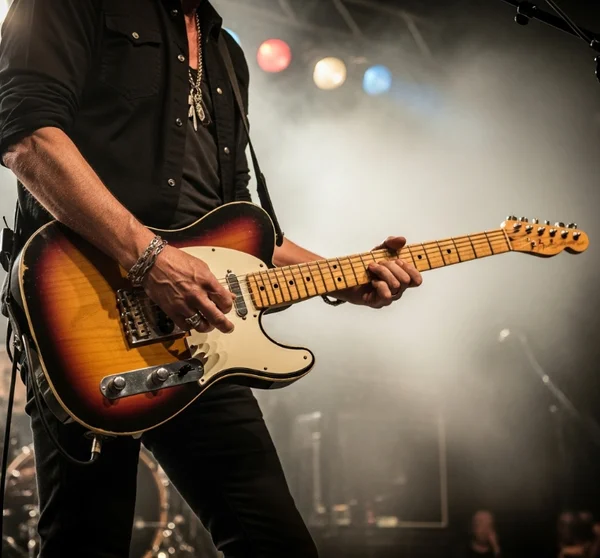Unlock New Sounds: Exploring Open G Tuning for Guitar
Discover DGDGBD: Your Guide to Open G Tuning, Blues & Slide
Tired of the same old EADGBE? Standard guitar tuning is fantastic, but a whole universe of sonic possibilities awaits those willing to venture beyond. Open G tuning (DGDGBD) is one of the most iconic and rewarding alternate tunings, famous for its rich sound and its deep roots in blues and rock music. This guide will walk you through everything you need to know to unlock the power of Open G.
Understanding Open G Tuning: The DGDGBD Configuration
So, what exactly makes Open G tuning special? It all comes down to the notes your strings are tuned to.
-
The Notes of Open G: From Low to High (D-G-D-G-B-D)
Unlike standard tuning, in Open G, your guitar strings are tuned to:
- 6th string (lowest): D
- 5th string: G
- 4th string: D
- 3rd string: G
- 2nd string: B
- 1st string (highest): D
-
Why "Open"? The Sound of a G Major Chord Strummed Open
The "open" in Open G means that if you strum all the strings without fretting any notes, you'll hear a full G major chord. This is a fundamental characteristic that makes playing certain chord voicings incredibly easy.
-
A Brief History: Where Did Open G Tuning Come From?
Open G tuning has a rich history, particularly in American folk and blues music. Early blues pioneers like Robert Johnson and Blind Willie McTell utilized open tunings to achieve the raw, expressive sounds that defined the genre. Later, rock icons like Keith Richards of The Rolling Stones famously adopted Open G, making it a staple in rock and roll.
Tuning Your Guitar to Open G (DGDGBD)
Ready to try it out? Retuning your guitar from standard to Open G is straightforward. Here's how, and remember, you can use a reliable online tuner like ours for precise results.
-
Starting from Standard Tuning (EADGBE)
Ensure your guitar is first in standard EADGBE tuning. This gives you a clear reference point.
-
Tuning the 6th String (Low E) Down to D
Locate your thickest string (the low E). You'll need to tune this string down a whole step to D. Pluck the string and adjust the tuning peg until your tuner shows a D.
-
Tuning the 5th String (A) Down to G
Move to the next string (the A string). Tune this string down a whole step to G.
-
Keeping the 4th (D), 3rd (G), and 2nd (B) Strings the Same
Good news! The 4th (D), 3rd (G), and 2nd (B) strings remain unchanged from standard tuning.
-
Tuning the 1st String (High E) Down to D
Finally, take your thinnest string (the high E) and tune it down a whole step to D.

-
Using an Online Tuner for Accurate DGDGBD Tuning
Double-check all your strings. An accurate microphone-based tuner is invaluable here. Strum all the open strings – you should hear that beautiful G major chord! Our
tuner.wikiprovides real-time pitch detection to help you nail each note perfectly.
The Sonic Character: Advantages of Guitar Open G Tuning
Open G isn't just different; it offers unique sonic qualities and playing advantages:
-
Rich, Resonant Bass Notes and Drones
The lower D and G strings provide a deep, resonant foundation, perfect for creating droning effects that add a lot of character to your music.
-
Easy One-Finger Chords and Barre Simplicity
Because the open strings form a G major chord, you can play major chords up and down the neck simply by barring one finger across all strings at a specific fret. This makes playing some progressions remarkably simple.
-
Perfect for Blues Riffs and Slide Guitar Techniques
The layout of Open G is incredibly well-suited for classic blues riffs and, notably, for slide guitar. The consistent intervals make it easier to create those wailing slide licks.
-
Inspiration for Songwriting and New Melodies
Changing your tuning can be a fantastic way to break out of creative ruts. Open G often inspires new melodic ideas and chord voicings you might not discover in standard tuning.
Basic Open G Chords You Need to Know
While the open strum is G major, you'll want to know a few other essential chord shapes. Here are some basics to get you started (chord diagrams are widely available online):
-
The G Major Chord (Open Strum)
As mentioned, just strum all open strings!
-
Playing C Major in Open G
A common way to play C major involves fretting the 5th string at the 5th fret, the 4th string at the 5th fret, and letting the others ring (or fretting them accordingly for different voicings).
-
Finding D Major in Open G
Similarly, D major can often be found by fretting around the 7th fret on certain strings, or by barring the 2nd fret and adding a finger.
-
Simple Minor Chords in Open G (e.g., Em, Am - adapted)
Minor chords require slightly different shapes. For example, an Em might involve fretting the 5th string at the 2nd fret and the 4th string at the 2nd fret. Experimentation is key.

-
Chord Diagrams for Easy Learning
Searching for "Open G chord diagrams" will provide visual aids to help you learn these shapes quickly.
Slide Guitar Mastery: Why Open G Tuning Shines
If you're interested in slide guitar, Open G is a fantastic tuning to explore.
-
How Open G Facilitates Smooth Slide Playing
The open G major chord means that when you place your slide straight across any fret, you get a major chord. This makes it intuitive to find melodies and chords with the slide. The D notes on the outer strings also provide great anchors.

-
Tips for Getting Started with Slide in Open G
- Use a light touch with the slide.
- Position the slide directly over the fret, not behind it.
- Mute unplayed strings with your fretting hand to keep things clean.
Legends of Open G: Guitarists and Songs in DGDGBD Tuning
The influence of Open G can be heard across various genres, thanks to these pioneers:
-
Keith Richards (The Rolling Stones) and His Signature Open G Riffs
Perhaps the most famous proponent of Open G (often with the low 6th string removed!), Keith Richards built many of The Rolling Stones' most iconic riffs like "Start Me Up," "Brown Sugar," and "Honky Tonk Women" around this tuning.

-
Classic Blues Artists and Their Open G Legacy
Blues legends such as Robert Johnson, Son House, and Muddy Waters frequently used open tunings, including variations of G, shaping the sound of modern music.
-
Modern Artists Exploring DGDGBD Sounds
Many contemporary artists continue to explore the sonic landscapes of Open G, from folk singers to alternative rockers, proving its enduring appeal.
Start Your Open G Tuning Adventure Today!
Open G tuning (DGDGBD) is more than just a different set of notes; it's a gateway to new sounds, playing styles, and creative inspiration. From its foundational role in blues and slide guitar to its iconic status in rock and roll, Open G offers a rich and versatile palette for any guitarist.
-
Recap: The Power and Versatility of Open G
We've covered what Open G is, how to tune to it, its unique advantages, essential chords, and its importance in slide and blues music, along with some legendary examples.
-
Your Turn: Experiment with DGDGBD
The best way to understand Open G is to try it yourself! Grab your guitar, use an easy online instrument tuner to get into DGDGBD, and start exploring. You'll be surprised at what you discover.
Your Open G Tuning Questions Answered
-
Is Open G tuning good for beginners?
It can be! While different from standard, the ability to play major chords with one finger can be very encouraging for beginners. However, learning standard tuning first is generally recommended for a broader understanding.
-
What kind of music is Open G tuning used for?
It's most famously used in blues, rock, folk, and slide guitar. However, its versatility allows it to be used in many genres.
-
Can I play regular chords in Open G tuning?
Yes, but the shapes will be different from standard tuning. You'll need to learn new fingerings for familiar chords.
-
Do I need special strings for Open G tuning?
No, standard guitar strings work fine. Some players who exclusively use Open G might opt for slightly different gauges to optimize tension, but it's not a requirement.
-
Besides DGDGBD, are there other Open G variations?
Yes, sometimes players might tune the B string up to a D for a DGDGDD tuning, or Keith Richards famously often removed the low D string entirely. DGDGBD is the most common, though.